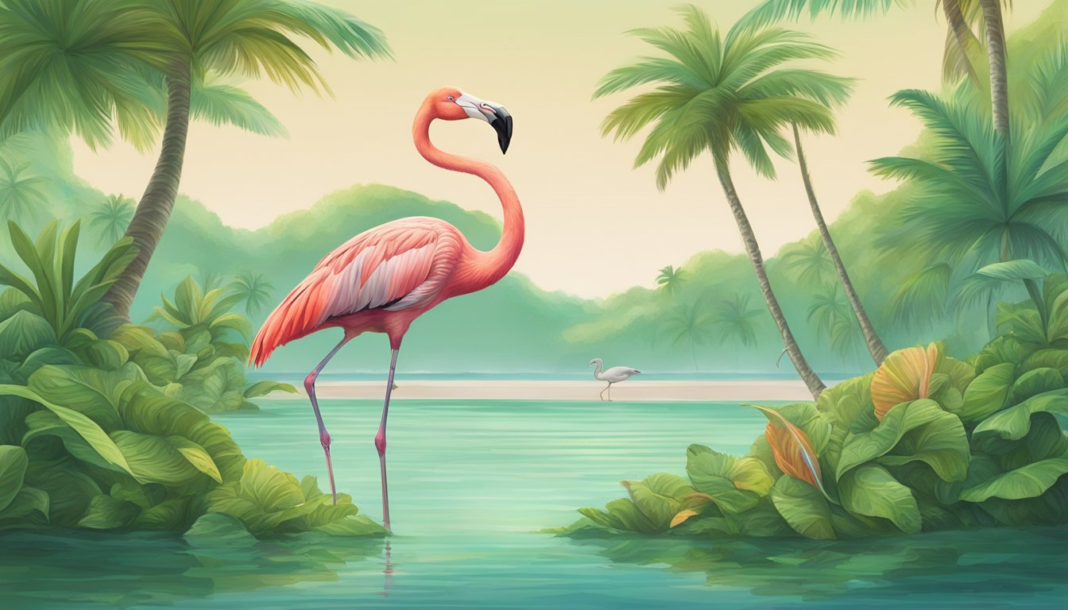The Caribbean is known not only for its crystal-clear waters and white sandy beaches but also for its incredible biodiversity. From lush rainforests to coral reefs, the region is home to a variety of unique and exotic wildlife.
Whether you’re a seasoned nature enthusiast or a casual traveler, spotting some of these fascinating creatures in the wild is an unforgettable experience. From colorful birds to elusive reptiles, the Caribbean offers ample opportunities to connect with nature and witness animals in their natural habitats.
In this guide, we’ll explore the top 10 Caribbean animals you must see in the wild, highlighting where and how to spot them.
1. Caribbean Flamingo (Phoenicopterus ruber)
Where to See Them: Bahamas, Cuba, Bonaire
The Caribbean flamingo is one of the most iconic and recognizable birds in the region, known for its striking pink plumage and graceful stance. These flamingos thrive in saline lagoons, mudflats, and shallow coastal areas where they feed on crustaceans, algae, and tiny organisms that give them their pink color. Watching a large flock of flamingos wade through the water is an awe-inspiring sight.
Flamingos can be found in several Caribbean locations, with some of the best sightings in the Bahamas’ Inagua National Park, Cuba’s Zapata Swamp, and Bonaire’s Flamingo Sanctuary.
Fun Fact: Flamingos get their pink color from the carotenoid pigments in the crustaceans and algae they consume.
2. Green Sea Turtle (Chelonia mydas)
Where to See Them: Barbados, Antigua, Cayman Islands
The green sea turtle is a majestic marine creature that glides through the warm waters of the Caribbean. These turtles are a frequent sight in coral reefs, seagrass beds, and coastal lagoons, where they feed on seaweed and algae. Seeing green sea turtles in the wild is a highlight for snorkelers and divers.
You can swim alongside these gentle creatures in Barbados at Carlisle Bay, observe them nesting in Antigua, or dive with them in the Cayman Islands’ Stingray City.
Fun Fact: Despite their name, green sea turtles aren’t always green; they are named after the greenish color of their body fat due to their herbivorous diet.
3. Barbados Green Monkey (Chlorocebus sabaeus)
Where to See Them: Barbados
The Barbados Green Monkey is a playful and charismatic species that is native to the island. Introduced to Barbados from West Africa in the 17th century, these monkeys now roam freely across the island. They are easily spotted in natural habitats like the Barbados Wildlife Reserve and Welchman Hall Gully, where they swing through the trees or forage on the ground.
These monkeys are known for their social behavior and are often seen in groups. While they are wild, they are accustomed to human presence, making them relatively easy to spot during a visit to one of the island’s nature reserves.
Fun Fact: Barbados Green Monkeys are named after the slight greenish hue of their fur, though they also have gray and brown tones.
4. Antillean Manatee (Trichechus manatus manatus)
Where to See Them: Dominican Republic, Puerto Rico, Belize
The Antillean manatee, also known as the West Indian manatee, is a gentle giant found in the warm coastal waters and river systems of the Caribbean. These slow-moving herbivores are often spotted in seagrass beds and mangroves, where they graze on aquatic plants. Despite their large size, they are peaceful and curious animals, making them a delight to encounter in the wild.
The best places to see manatees in the Caribbean include the Dominican Republic’s Estero Hondo Marine Mammal Sanctuary, the coastal waters of Puerto Rico, and Belize, where they inhabit mangrove lagoons.
Fun Fact: Manatees are distant relatives of elephants and can live up to 60 years in the wild.
5. Iguanas (Various Species)
Where to See Them: St. Lucia, Cayman Islands, Dominica
The Caribbean is home to several species of iguanas, each offering a unique glimpse into the region’s reptilian wildlife. One of the most notable species is the St. Lucia Iguana, which is endemic to the island and can be found in its rainforests and along the coastline. In the Cayman Islands, the critically endangered Blue Iguana is a must-see species that has made a remarkable comeback thanks to conservation efforts. On the island of Dominica, you can spot the Lesser Antillean Iguana, another critically endangered species that roams the forests.
These large lizards can often be seen basking in the sun, camouflaged among the greenery. Many Caribbean iguana species are threatened by habitat loss and invasive predators, making conservation efforts crucial to their survival.
Fun Fact: The Blue Iguana, native to the Cayman Islands, can grow up to five feet in length and is known for its vibrant blue hue.
6. Humpback Whale (Megaptera novaeangliae)
Where to See Them: Dominican Republic, Turks and Caicos, Puerto Rico
One of the most breathtaking marine experiences in the Caribbean is witnessing humpback whales on their annual migration. Every winter, from December to March, these majestic creatures migrate to the warm waters of the Caribbean to breed and give birth. The Dominican Republic’s Silver Bank is one of the best places in the world for whale watching, as it is a designated sanctuary for these marine giants.
Other prime locations for whale watching include the Turks and Caicos Islands and Puerto Rico’s Mona Passage, where humpback whales can often be seen breaching and slapping their tails in the water.
Fun Fact: Humpback whales are known for their complex songs, which can travel over great distances underwater.
7. Scarlet Ibis (Eudocimus ruber)
Where to See Them: Trinidad and Tobago
The Scarlet Ibis is a striking bird known for its vibrant red feathers, making it one of the most recognizable species in the Caribbean. These birds thrive in wetlands and mangroves, and their fiery plumage is due to their diet of crustaceans, which contain pigments called carotenoids.
One of the best places to see these birds in their natural habitat is the Caroni Swamp in Trinidad, where large flocks of scarlet ibises roost in the trees at sunset, creating a stunning spectacle of color. Birdwatchers flock to this reserve to witness the birds’ daily migration from feeding grounds to their roosting sites.
Fun Fact: The Scarlet Ibis is the national bird of Trinidad and Tobago, symbolizing the country’s rich biodiversity.
8. Frogs of the Caribbean (Various Species)
Where to See Them: Dominica, Puerto Rico, Jamaica
The Caribbean is home to several species of frogs, including the Coquí Frog of Puerto Rico, known for its distinctive “co-kee” call that fills the night air. Another notable species is the Mountain Chicken Frog of Dominica, one of the largest frog species in the world, though critically endangered.
Frogs play an important role in the Caribbean’s ecosystems, especially in rainforest regions where they are crucial for maintaining insect populations. They are often heard more than seen, with their vocalizations providing a unique soundtrack to tropical nights.
Fun Fact: The Coquí is named after the sound it makes and is considered a symbol of Puerto Rican pride.
9. Solenodon (Solenodon paradoxus)
Where to See Them: Dominican Republic, Haiti
The Solenodon is one of the Caribbean’s most mysterious and rare animals. Resembling a large shrew, this nocturnal mammal is one of the few venomous mammals in the world. It is native to the island of Hispaniola, which includes the Dominican Republic and Haiti. Due to habitat loss and predation by introduced species, the solenodon is critically endangered and rarely seen.
However, conservation efforts are underway to protect this unique species, and wildlife enthusiasts may have the opportunity to spot one in the wild, particularly in the remote forests of the Dominican Republic.
Fun Fact: The Solenodon has remained relatively unchanged for millions of years, making it a “living fossil.”
10. Frigatebird (Fregata magnificens)
Where to See Them: The Bahamas, St. Kitts and Nevis, Antigua
Frigatebirds are large seabirds with long wings and forked tails, often seen gliding effortlessly over the Caribbean Sea. Male frigatebirds are especially notable for the bright red throat pouch they inflate during courtship displays. These birds are known for their aerial agility and are sometimes called “pirate birds” because they steal food from other seabirds.
Frigatebirds are commonly spotted near coastal areas, often soaring above islands like The Bahamas, St. Kitts and Nevis, and Antigua, where they nest in colonies.
Fun Fact: Frigatebirds can stay aloft for weeks at a time, covering vast distances over the ocean without ever landing.
Conclusion
The Caribbean is a haven for wildlife enthusiasts, offering the chance to see some of the world’s most unique and diverse species in their natural habitats. From the playful Barbados Green Monkey to the awe-inspiring humpback whale, the region’s ecosystems are teeming with life. Whether you’re exploring rainforests, snorkeling in coral reefs, or embarking on a birdwatching tour, these top 10 animals represent just a glimpse of the incredible biodiversity the Caribbean has to offer.
FAQ
What is the best time to see humpback whales in the Caribbean?
The best time to see humpback whales in the Caribbean is during their migration season, which runs from December to March. The Dominican Republic and Puerto Rico offer some of the best whale-watching opportunities.
Where can I see flamingos in the Caribbean?
You can see flamingos in the Caribbean at places like Inagua National Park in the Bahamas, Bonaire Flamingo Sanctuary, and Cuba’s Zapata Swamp.
Are there any venomous animals in the Caribbean?
Yes, one of the few venomous mammals in the world, the Solenodon, can be found in the Dominican Republic and Haiti.
What are some of the most endangered species in the Caribbean?
Endangered species in the Caribbean include the Blue Iguana in the Cayman Islands, the Lesser Antillean Iguana in Dominica, and the Mountain Chicken Frog in Dominica.
Where is the best place to see manatees in the Caribbean?
Manatees can be seen in the Estero Hondo Marine Mammal Sanctuary in the Dominican Republic, coastal waters of Puerto Rico, and Belize, particularly in mangrove lagoons.

